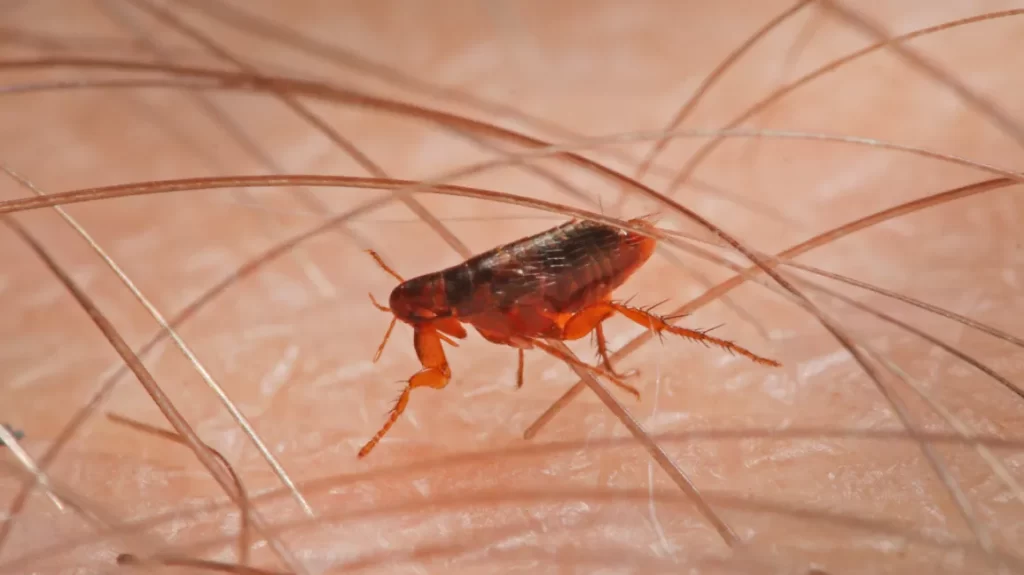Flea Biology and Identification
Fleas are small, wingless insects that are known for their ability to jump and feed on the blood of warm-blooded animals, including humans. These parasitic pests can cause a range of problems, from annoying itchy bites to the potential transmission of diseases. Understanding the physical characteristics and behavior of fleas is crucial for effective identification and control.
Flea Appearance and Morphology
Fleas are small, typically ranging from 1.5 to 3.3 millimeters (1/16 to 1/8 inch) in length. They have a flattened, oval-shaped body that is covered in a hard, protective shell called a sclerite. The flea’s body is laterally compressed, which allows it to move easily through the fur or feathers of its host.The flea’s body is typically dark in color, often reddish-brown or black, which helps it blend in with its host’s fur or skin. When a flea has recently fed on blood, its body may appear reddish-black or darker in color. Fleas have a distinct set of physical features that aid in their parasitic lifestyle:
Mouthparts: Fleas have a proboscis, or stylet, that is adapted for piercing the skin and sucking blood from their host. This proboscis is located at the front of the flea’s head.
Legs: Fleas have six strong, spiny legs that end in sharp claws. These legs are adapted for grasping onto the host’s fur or skin and jumping long distances. The hind legs, in particular, are large and powerful, allowing fleas to jump up to 200 times their own body length.
Eyes: Fleas do not have compound eyes like many other insects. Instead, they have simple eyespots with a single biconvex lens. Some flea species even lack eyes altogether.
Antennae: Fleas have short, inconspicuous antennae that are tucked into grooves on the sides of their heads when not in use.
Larvae: Flea larvae are small, worm-like creatures that lack legs and eyes. They have bristles covering their bodies and feed on organic matter, including the dried blood in adult flea feces.
Flea Behavior and Lifecycle
Fleas are obligate parasites, meaning they rely on a host animal for survival and reproduction. The flea lifecycle consists of four stages: egg, larva, pupa, and adult.
Eggs: Fleas lay tiny, white, oval-shaped eggs, which are often deposited in the host’s fur or feathers, or in cracks and crevices of the host’s environment.
Larvae: The eggs hatch into small, pale-colored larvae that feed on organic matter, including the dried blood in adult flea feces. Larvae have no eyes and move by crawling.
Pupae: The larvae spin cocoons and enter the pupal stage, where they undergo metamorphosis into adult fleas. The pupal stage can last from a few days to several months, depending on environmental conditions.
Adults: Once the adult fleas emerge from their cocoons, they are ready to find a host and begin feeding on blood. Adult fleas are capable of jumping long distances to reach their hosts, and they can survive for several months without a blood meal.Fleas are known for their ability to jump, with some species capable of jumping up to 200 times their own body length. This impressive jumping ability allows them to quickly reach their host and move through the host’s fur or feathers.
Common Flea Species
There are over 2,500 species of fleas worldwide, but a few species are particularly common and problematic for humans and their pets.
| Flea Species | Host | Description | Source |
|---|---|---|---|
| Cat Flea (Ctenocephalides felis) | Cats, dogs, and other mammals | The most common flea species found in homes. Dark reddish-brown in color. | |
| Dog Flea (Ctenocephalides canis) | Dogs, cats, and other mammals | Similar in appearance to the cat flea, but slightly larger. | |
| Human Flea (Pulex irritans) | Humans, pigs, and other mammals | Smaller than the cat and dog fleas, with a more rounded body shape. | |
| Rat Flea (Xenopsylla cheopis) | Rats, mice, and other rodents | Known for its role in the transmission of bubonic plague. |
Flea Bites and Potential Diseases
Fleas feed on the blood of their hosts, which can lead to a range of problems, from annoying itchy bites to the potential transmission of diseases.Flea Bites: Flea bites typically appear as small, red, itchy bumps on the skin. They are often found in clusters or lines, as a single flea can bite multiple times in the same area. Flea bites can cause intense itching and may lead to secondary skin infections due to scratching. Flea-Borne Diseases: Fleas are known to transmit several diseases, including:
- Bubonic plague: Fleas can transmit the bacterium Yersinia pestis, which causes bubonic plague. This disease was responsible for devastating pandemics in the past, such as the Black Death.
- Murine typhus: Fleas can transmit the bacterium Rickettsia typhi, which causes murine typhus, a potentially serious illness.
- Tapeworms: Fleas can act as an intermediate host for certain tapeworm species, which can be transmitted to humans and pets.
While the risk of disease transmission from fleas in the United States is generally low, it is important to take steps to prevent and control flea infestations to protect the health and well-being of both humans and their pets.
FAQ
What do fleas look like?
Fleas are small, wingless insects that are typically dark reddish-brown or black in color. They have a flattened, oval-shaped body and are about 1.5 to 3.3 millimeters (1/16 to 1/8 inch) in length. Fleas have six strong, spiny legs that end in sharp claws, which allow them to grasp onto their host’s fur or skin. They also have a proboscis, or stylet, that is adapted for piercing the skin and sucking blood from their host.
What are the different types of fleas?
There are over 2,500 species of fleas worldwide, but some of the most common and problematic species include:
- Cat Flea (Ctenocephalides felis)
- Dog Flea (Ctenocephalides canis)
- Human Flea (Pulex irritans)
- Rat Flea (Xenopsylla cheopis)
The cat flea is the most common domestic flea and is found on both cats and dogs, as well as other mammals. The dog flea is similar in appearance to the cat flea but is slightly larger. The human flea is smaller than the cat and dog fleas, with a more rounded body shape. The rat flea is known for its role in the transmission of bubonic plague.
How do fleas reproduce and spread?
Fleas have a four-stage lifecycle: egg, larva, pupa, and adult. Fleas lay their tiny, white eggs in the host’s fur or feathers, or in cracks and crevices of the host’s environment. The eggs hatch into small, pale-colored larvae that feed on organic matter, including the dried blood in adult flea feces. The larvae then spin cocoons and undergo metamorphosis into adult fleas, which emerge ready to find a host and begin feeding on blood.Fleas can spread quickly, as a single female flea can lay up to 50 eggs per day, and the entire lifecycle can be completed in as little as 2-3 weeks under optimal conditions. Fleas can also jump long distances, up to 200 times their own body length, which allows them to easily move from one host to another.
What are the dangers of flea infestations?
Fleas can pose several dangers to both humans and their pets:
- Flea Bites: Flea bites can cause itchy, red bumps on the skin, which may lead to secondary skin infections due to scratching.
- Disease Transmission: Fleas can transmit diseases such as bubonic plague, murine typhus, and tapeworms.
- Anemia in Pets: Heavy flea infestations can lead to blood loss and anemia in pets, particularly in young or small animals.
- Allergic Reactions: Some people and pets may have allergic reactions to flea saliva, resulting in more severe symptoms like swelling, hives, or difficulty breathing.
It is important to take steps to prevent and control flea infestations to protect the health and well-being of both humans and their pets.
How can I get rid of fleas?
Effective flea control involves a multi-pronged approach that targets both the adult fleas and the immature stages (eggs, larvae, and pupae) in the environment. Some key steps include:
- Treating pets with approved flea control products
- Thoroughly cleaning and vacuuming the home, including carpets, furniture, and cracks and crevices
- Washing bedding and clothing in hot, soapy water
- Treating the yard and outdoor areas with insecticides or natural repellents
- Maintaining good sanitation and hygiene to prevent future infestations
It is important to follow the instructions carefully and consult with a veterinarian or pest control professional for the most effective and safe flea control methods.



